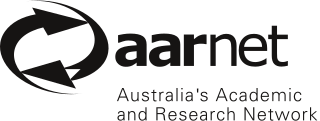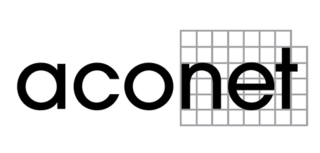CARNET is the national research and education network of Croatia. It is funded from the government budget and it operates from offices in Zagreb and five other cities.

Abilene Network was a high-performance backbone network created by the Internet2 community in the late 1990s. In 2007 the Abilene Network was retired and the upgraded network became known as the "Internet2 Network".

AARNet provides Internet services to the Australian education and research communities and their research partners.
Optical Carrier transmission rates are a standardized set of specifications of transmission bandwidth for digital signals that can be carried on Synchronous Optical Networking (SONET) fiber optic networks. Transmission rates are defined by rate of the bitstream of the digital signal and are designated by hyphenation of the acronym OC and an integer value of the multiple of the basic unit of rate, e.g., OC-48. The base unit is 51.84 Mbit/s. Thus, the speed of optical-carrier-classified lines labeled as OC-n is n × 51.84 Mbit/s.
The China Education and Research Network is the first nationwide education and research computer network in China. The CERNET project is funded by the Chinese government and directly managed by the Chinese Ministry of Education. It is constructed and operated by Tsinghua University and the other leading Chinese universities.

Netnod AB is a private limited company based in Stockholm, Sweden, that operates Internet exchange points and manages one of the thirteen root name servers for the Domain Name System (DNS). It also distributes the official Swedish time through the Network Time Protocol (NTP). It is fully owned by the nonprofit foundation TU-stiftelsen / TU-foundation.

The Energy Sciences Network (ESnet) is a high-speed computer network serving United States Department of Energy (DOE) scientists and their collaborators worldwide. It is managed by staff at the Lawrence Berkeley National Laboratory.

The physical-layer specifications of the Ethernet family of computer network standards are published by the Institute of Electrical and Electronics Engineers (IEEE), which defines the electrical or optical properties and the transfer speed of the physical connection between a device and the network or between network devices. It is complemented by the MAC layer and the logical link layer. An implementation of a specific physical layer is commonly referred to as PHY.

IPv4 address exhaustion is the depletion of the pool of unallocated IPv4 addresses. Because the original Internet architecture had fewer than 4.3 billion addresses available, depletion has been anticipated since the late 1980s when the Internet started experiencing dramatic growth. This depletion is one of the reasons for the development and deployment of its successor protocol, IPv6. IPv4 and IPv6 coexist on the Internet.
40 Gigabit Ethernet (40GbE) and 100 Gigabit Ethernet (100GbE) are groups of computer networking technologies for transmitting Ethernet frames at rates of 40 and 100 gigabits per second (Gbit/s), respectively. These technologies offer significantly higher speeds than 10 Gigabit Ethernet. The technology was first defined by the IEEE 802.3ba-2010 standard and later by the 802.3bg-2011, 802.3bj-2014, 802.3bm-2015, and 802.3cd-2018 standards. The first succeeding Terabit Ethernet specifications were approved in 2017.

CANARIE is the not-for-profit organisation which operates the national backbone network of Canada's national research and education network (NREN). The organisation receives the majority of its funding from the Government of Canada. It supports the development of research software tools; provides cloud resources for startups and small businesses; provides access and identity management services; and supports the development of policies, infrastructure and tools for research data management.

EMMAN was a company limited by guarantee and jointly owned by its members, eight Higher Education Institutions in the East Midlands region of the United Kingdom.
GARUDA(Global Access to Resource Using Distributed Architecture) is India's Grid Computing initiative connecting 17 cities across the country. The 45 participating institutes in this nationwide project include all the IITs and C-DAC centers and other major institutes in India.

The Atlanta Internet Exchange (AtlantaIX) is an Internet Exchange Point situated in Atlanta, Georgia, United States. AtlantaIX is a fast-growing, neutral and independent peering point. The beginnings of the AtlantaIX can be traced back to 1997. The current version of the AtlantaIX was re-established on September 4, 2003 by Michael Lucking, GreatAccess.com, WV Fiber and 56 Marietta Street Partners. AtlantaIX was originally created as a free exchange point sponsored by the donations of the founders. Today AtlantaIX continues to run without any re-occurring charges to the participants. In 2007, one time port fees were instituted to aid in paying for a recently upgraded switch infrastructure. In January 2007, Michael Lucking purchased a new Foundry Networks Jetcore 15000 in order to support 10 Gigabit Ethernet connections. In January 2008 the switch fabric was migrated to a Cisco 6509 in order to support line rate 10 gigabit Ethernet. In early 2008, the AtlantaIX began supporting IPv6.
The deployment of IPv6, the latest version of the Internet Protocol (IP), has been in progress since the mid-2000s. IPv6 was designed as the successor protocol for IPv4 with an expanded addressing space. IPv4, which has been in use since 1982, is in the final stages of exhausting its unallocated address space, but still carries most Internet traffic.
Juniper M series is a line of multiservice edge routers designed and manufactured by Juniper Networks, for enterprise and service provider networks. It spans over M7i, M10i, M40e, M120, and M320 platforms with 5 Gbit/s up to 160 Gbit/s of full-duplex throughput. The M40 router was the first product by Juniper Networks, which was released in 1998. The M-series routers run on JUNOS Operating System.

Education and Research Network (ERNET) is an autonomous scientific society of the Ministry of Electronics and Information Technology, Government of India. ERNET has made a significant contribution to the emergence of networking in the country. It practically brought the Internet to India and has built up national capabilities in the area of net-working, especially in protocol software engineering. It is the first internet service in india. It has not only succeeded in building a large network that provides various facilities to the intellectual segment of Indian society—the research and education community, it has over the years become a trendsetter in the field of networking.
The Ohio Academic Resources Network (OARnet) is a state-funded IT organization that provides member organizations with intrastate networking, virtualization and cloud computing solutions, advanced videoconferencing, connections to regional and international research networks and the commodity Internet, colocation services and emergency web-hosting.

AMRES is the National Research and Education Networking organisation (NREN) in Serbia. After it was founded on 22 April 2010 as an institution by the Serbian government, AMRES took over the responsibility for the academic network and the associated services from the Computer Centre of the University of Belgrade. AMRES represents Serbia in international forums such as TERENA, but the University of Belgrade is still the organisation representing Serbia in the project that provides the funding for the European backbone network GÉANT.

ACOnet is the name of the national research and education network in Austria. The ACONET association promotes the development and use of that network. ACOnet is not managed and operated by ACONET, but by a unit in the Computing Centre of the University of Vienna that also operates the Vienna Internet Exchange. The University of Vienna represents ACOnet internationally, for example as a member of TERENA and as a participant in the project that funds the European backbone network GÉANT.













